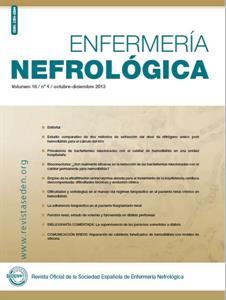Contenido del artículo principal
Resumen
El objetivo principal fue comparar la diuresis y la función renal de los pacientes incidentes en diálisis peritoneal y su evolución en función al uso de furosemida.
El objetivo secundario fue valorar si la furosemida puede mejorar el estado de volumen.
Material y métodos: Se realizó un estudio retrospectivo, comparativo, longitudinal y multicéntrico. La muestra fueron 40 pacientes.
En una unidad se utilizaron diuréticos (grupo furosemida) y en otra no (grupo control). Se recogieron variables del estudio al inicio, 6 y 12 meses. El análisis se realizó con el SPSS 19.
Resultados: El 57,5% de los pacientes eran hombres. La edad media fue 56,45 + 16,2 años. La etiología más prevalente fue la nefritis intersticial. Ningún paciente presentó efectos secundarios.
La diuresis evolucionó igual en ambos grupos, siendo superiores en el grupo furosemida sin significación.
No hallamos diferencias significativas a lo largo del estudio para la diuresis, filtrado glomerular, peso, índice masa corporal y ultrafiltración media. El 40% de los pacientes del grupo control presentaron edemas a los 6 meses frente al 17,6% del grupo furosemida. El grupo control utilizó mayor número de intercambios hipertónicos durante el primer año.
El grupo furosemida mostró presiones arteriales sistólicas y diastólicas superiores y utilizó más hipotensores aunque sin significación.
Conclusiones: La administración de dosis bajas de diuréticos no ha mostrado diferencias significativas para la diuresis y la función renal durante el primer año en diálisis peritoneal.
Quizás por las bajas dosis, el uso de diuréticos no mejoró los parámetros relacionados con el estado de volumen.
El objetivo secundario fue valorar si la furosemida puede mejorar el estado de volumen.
Material y métodos: Se realizó un estudio retrospectivo, comparativo, longitudinal y multicéntrico. La muestra fueron 40 pacientes.
En una unidad se utilizaron diuréticos (grupo furosemida) y en otra no (grupo control). Se recogieron variables del estudio al inicio, 6 y 12 meses. El análisis se realizó con el SPSS 19.
Resultados: El 57,5% de los pacientes eran hombres. La edad media fue 56,45 + 16,2 años. La etiología más prevalente fue la nefritis intersticial. Ningún paciente presentó efectos secundarios.
La diuresis evolucionó igual en ambos grupos, siendo superiores en el grupo furosemida sin significación.
No hallamos diferencias significativas a lo largo del estudio para la diuresis, filtrado glomerular, peso, índice masa corporal y ultrafiltración media. El 40% de los pacientes del grupo control presentaron edemas a los 6 meses frente al 17,6% del grupo furosemida. El grupo control utilizó mayor número de intercambios hipertónicos durante el primer año.
El grupo furosemida mostró presiones arteriales sistólicas y diastólicas superiores y utilizó más hipotensores aunque sin significación.
Conclusiones: La administración de dosis bajas de diuréticos no ha mostrado diferencias significativas para la diuresis y la función renal durante el primer año en diálisis peritoneal.
Quizás por las bajas dosis, el uso de diuréticos no mejoró los parámetros relacionados con el estado de volumen.
Palabras clave
Diálisis peritoneal; diuréticos; función renal residual.
Detalles del artículo
Licencia
Aviso de derechos de autor/a
© Los autores ceden de forma no exclusiva los derechos de explotación de los trabajos publicados y consiente en que su uso y distribución se realice con la Licencia Creative Commons Atribución - No comercial 4.0 Internacional (CC BY-NC 4.0). Puede consultar desde aquí la versión informativa y el texto legal de la licencia. Esta circunstancia ha de hacerse constar expresamente de esta forma cuando sea necesario.
Cómo citar
1.
Cirera Segura F, Martín Espejo JL, Gómez Castilla AC, Ojeda Guerrero M Ángeles, Andreu-Periz D, Hidalgo-Blanco M Ángel, et al. Función renal, estado de volemia y furosemida en diálisis peritoneal. Enferm Nefrol [Internet]. 2014 [consultado 2 Nov 2025];16(4):[aprox. 7 p.]. Disponible en: https://www.enfermerianefrologica.com/revista/article/view/4177




